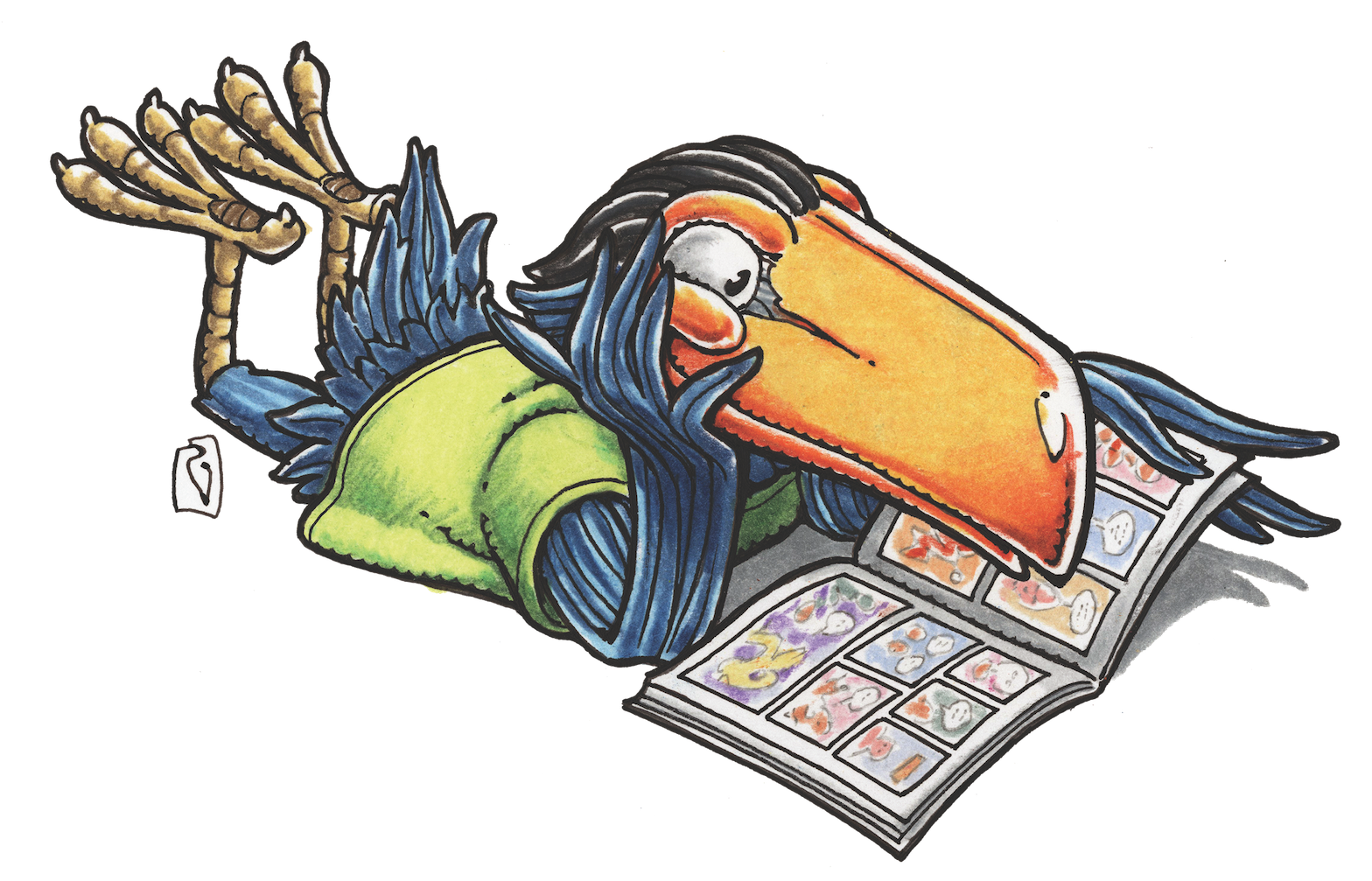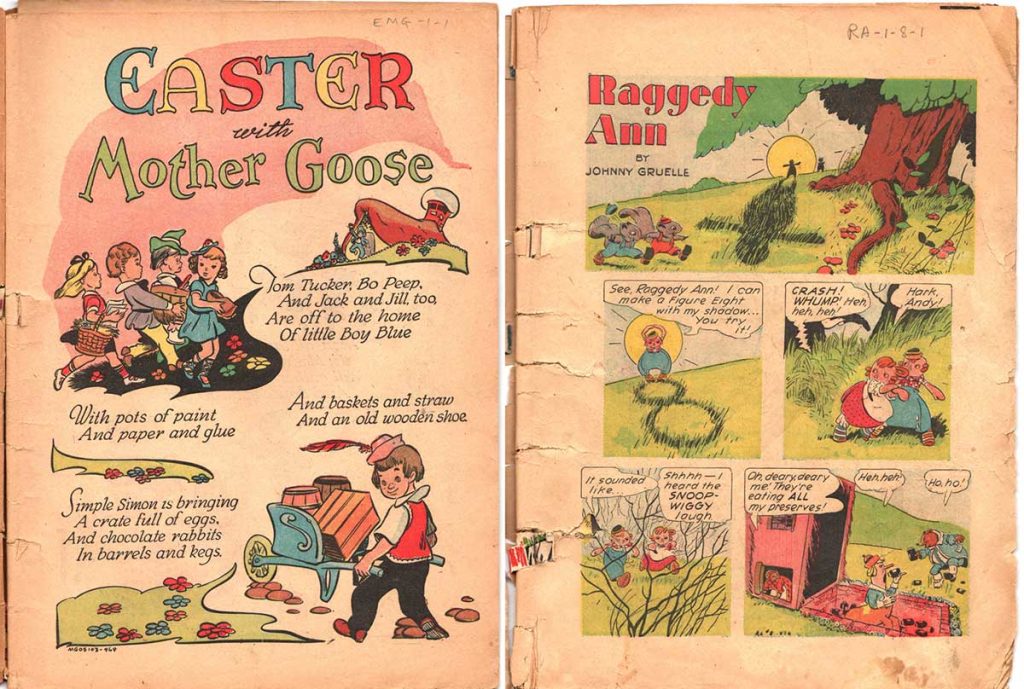MAGGIE’S WORLD BY MAGGIE THOMPSON
Maggie’s World 064: It Begins

A Social Media Challenge
Facebook friend Steven Carroll passed on to me one of those tasks, sent to him by someone else. He invited me to post “10 comic books that made an impact on you the first time you saw them and still enjoy reading today. Only one cover per title/series. Post the cover, no need to explain why, and then nominate a new person each day to do the same.”
Let me make it clear: I don’t do these things. By which I mean I never dump these projects on others. On the other hand, I thought the job itself might teach me something. So I responded with my 10. Posting them in chronological order, they were Raggedy Ann + Andy #8 (January 1947); Animal Comics #25 (February 1947); Dell Four Color #139 (Little Lulu) (March 1947); Dell Four Color (Walt Disney’s Donald Duck in The Old Castle’s Secret) #189 (June 1947); Tarzan #39 (December 1952); Mad #9 (February 1954); Incredible Science Fiction #30 (July 1955); The Cartoon History of the Universe #1 (September 1978); Sandman #1 (January 1989); and Bone #1 (July 1991).
And I was surprised that the exploration raised questions for me, beginning with a question to which I thought I’d already had the answer.
When Did You Start to Read Comics?
There’s a photo of me reading Marvel’s Comic Capers #6 (Fall 1946). I’d have been 3. (How convenient is it that comics carry publication dates?) And I have a memory of Mom’s liking a character name from a Punch-and-Judy-associated series published around then: either Fawcett’s George Pal’s Puppetoons or Hillman’s Punch and Judy Comics. (The name, recalling it 70 years later, was “Sylvester Buttery Barth.” I think he was a villain, but details of those comics remain largely unavailable, and he doesn’t turn up in an online search.)
In any case, of course, when I use the word “reading,” I mean that I was (age 3!) looking at the pictures. But until I did this research, I’d almost always said that my interests in comics began when I was 5. In any case …

When Did You Start to Collect Comics?
Comics I still own (sometimes via replacements) are:
1946
- April, Dell Four Color #103, “Easter with Mother Goose.” I was 3. I still have the copy I bought from the newsstand with my weekly dime allowance.
- July, Dell Four Color #114, “Fairy Tale Parade.”
- December, Dell Four Color #128, “Santa Claus Funnies.” I was 4.
1947
- January, Raggedy Ann + Andy #8.
- February, Animal Comics #25
- May, Dell Four Color #148 (“Albert the Alligator and Pogo Possum”)
I own them, because they kicked off my own comic-book collecting. I’d bought other comics—but these are the ones I kept. My mother taught me that, if I didn’t buy what I liked—or didn’t then hold onto them—I wouldn’t be able to find a copy of that issue at the library.
I had to keep comics, take care of them, and store them where I could find them to read them again and again. And she helped. This was in a day when few thought of protecting fragile comics in plastic bags. In fact, the Internet says plastic food-storage bags weren’t introduced until 1957, so they weren’t even available to protect comics in the Golden Age. Kids reading and trading comics just kept them in drawers or stacked on shelves. (Why are Near Mint Golden Age comics so rare? Because the only ones that survived in that shape weren’t handled or read or left out in the open. But I digress.)
How do I know that Four Color #103 is the copy I bought? Because another facet of collecting is keeping track of the accumulation. And Mom did so before I could read and write. She kept an inventory of what I had—noted on the top of the first inside page of each.
Mom even made “books” of some of my comics by cutting matting board into protective covers, making spines out of The Borden Chemical Company’s “Mystik Brand Self-Stik Plastic Coated Cloth Tape,” and then rubber-banding each issue onto that spine. That way, I could read a series in sequence.

As Time Goes On …
Comics change, stories change, tastes change.
A funny-animal story involving an invisible sword-wielding skeleton freaked me out when I was 5. Nevertheless, as I grew older, I became fascinated with scary science fiction and fantasy stories.
As time went on, satiric comic books became A Thing, and some of the best storytelling came from a company telling stand-alone short stories. The quality of the E.C. line produced its own fandom, before the later, more generally focused, comics fandom.

In fact, E.C. seemed to pride itself, not only on providing a wide variety of artistic styles, but also on encouraging its artists to sign their work. Whereas some other publishers encouraged a “house style” of similar art, E.C. pointed out the distinctions of its artists’ varying approaches. Heck, some Dell series back in the day credited a creator who had had nothing to do with writing or drawing the stories, while the artists were tasked with copying the originator’s style. Mom thought Johnny Gruelle had written and drawn the “Raggedy Ann” story in that January 1947 issue; Gruelle had died in 1938, and she’d never heard of actual artist George Kerr. Such writer-artists as Carl Barks and John Stanley didn’t get to sign their stories. But by the 1960s, fans began to identify their favorite anonymous creators.
And some of us began to take each other further behind the scenes in the theater of comic books, comic strips, animated cartoons, magazine cartoons, and the like.
How Did It Begin for You?
Were you captivated by what you found in the grocery-store checkout lane? Did you go from newsstand to newsstand to find the latest issues? Were comics shops your door to the art form?
Now, beginning comics readers can go to libraries to catch up on stories from earlier issues—and even from earlier decades!
They’ll find classic comics stories alongside a wonderful supply of new tales. Keen, right?
Maggie’s World by Maggie Thompson appears the first Tuesday of every month here on Toucan!